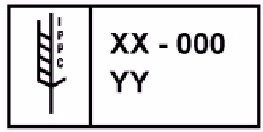Introduction
Wood packaging material made of unprocessed wood is a pathway for the introduction and spread of pests, including pathogens, detrimental to agriculture and to natural, cultivated, and urban forest resources. The United States and other countries have committed to enforce the International Standards for Phytosanitary Measures (ISPM) 15 which is a standard of guidelines for regulating wood packing material (WPM) in international trade to reduce the risk of introduction and/or spread of harmful pests. ISPM 15 calls for regulated WPM to be either heat treated or fumigated with methyl bromide and marked in a certain way certifying treatment. Only accredited agencies can perform these functions.
WPM for Importers into the U.S.
The wood packing material final rule requires WPM, such as pallets, crates, boxes, and dunnage used in international trade to support or brace cargo, to be treated to prevent the introduction of insects harmful to U.S. agriculture and forests. WPM need not be bark free as long as it is treated. WPM does not include manufactured wood such as plywood, veneer, fiberboard, particle board, corrugated board, or oriented strand board. Also excluded are loose wood materials such as shavings and excelsior, whisky and wine barrels, wine crates for vintage years prior to 2006, ammo crates, and paper products. The approved treatments are :
- heat treatment to a minimum wood core temperature of 56° C/133° F for a minimum of 30 minutes, or
- fumigation with methyl bromide
To certify treatment, the WPM must be marked in a visible location, preferably on at least 2 opposite side of the article, with the approved International Plant Protection Convention (IPPC) logo. The mark must be legible and permanent. The mark will include the IPPC graphic symbol, the ISO country code for the country that treated the WPM, a unique number assigned by the national plant protection agency of that country to the producer of the wood packaging material, and an abbreviation showing the type of treatment (HT for heat treatment or MB for methyl bromide).

Decoding
XX = Country of manufacture
000 = Code traceable to the source (e.g., pallet manufacturer)
YY = Treatment Measure (HT or MB)
Unauthorized use of the IPPC logo and treatment mark is a violation of trademark laws. Licensed fumigators not registered in this program can still fumigate wood packaging and certify these products on their own but they are not authorized to apply the treatment mark or any mark similar to it.
Verification of compliance with the WPM rules is by visual inspection only. A statement on shipping documents is neither required or nor accepted.
What is most important regarding the WPM rules is the requirement that the IPPC marking be VISIBLE. We have had several instances where pallets were marked, but because of the way the pallet was loaded, the marking was not visible when APHIS (Animal and Plant Health Inspection Service) inspectors opened the container. The shipments were refused and had to be re-exported at considerable cost, simply because the pallet was turned the wrong way around. Be sure that the last pallets (or crates or other WPM) loaded in the container have the IPPC marking facing out.
Unmarked WPM will be considered untreated and non-compliant, and must be either re-exported or separated from the cargo at the importer’s expense. Post-entry treatment or incineration will not be allowed. For cargo that must be re-exported, many steamship lines will require a letterhead statement from the foreign shipper that they will accept the returned goods.
U.S. Customs and Border Protection (CBP) may issue claims for liquidated damages and/or penalties against importers for violation of WPM regulations.
U.S. Customs information including FAQs on the WPM program may be found here.
WPM for Exports out of the U.S.
A list of countries requiring ISPM 15 may be found here on the United States Department of Agriculture- Animal Plant Health Inspection Services website. The list of countries may change as other countries implement the ISPM 15 or similar measures. Please note these countries may not have adopted the exact same recommendations as the U.S. It is prudent to check the specific country regulations prior to export.
Countries requiring ISPM 15 implementation will accept only properly treated and marked WPM under a marking system of the exporting country. To make the WPM suitable for international shipment, it must be marked with the HT or MB treatment mark. To apply the mark, the facility (i.e., pallet manufacturing or recycling, pest control, cargo forwarding, export brokerage) must be certified by an inspection agency. These agencies provide inspection and auditing services to certified facilities that use the IPPC treatment mark.
Please refer to this link for certified fumigators and a list of accredited inspection agencies from the National Wooden Pallet and Container Association. The American Lumber Standard Committee (ALSC) website has a list of untreated lumber accredited agencies, treated wood accredited agencies, and wood packing material accredited agencies.

